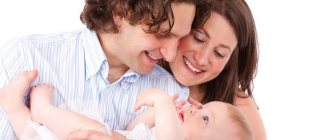10/08/2020 Reading time: 5 min 36934 0
Six months is the baby’s first full anniversary, and, of course, loving parents are interested in his development. The question of what a child can do at 6 months worries both mom and dad: they need to know this in order to understand in time whether the baby is developing normally. Of course, this is not a newborn baby in any case: a six-month-old baby can do much more, delighting parents with his curiosity about the world and his first attempts to move independently. Remember that each baby develops individually and different children at the same age behave slightly differently from each other. But there are basic criteria that you can focus on.
Features of child development at 6 months
A six-month-old baby is on average 65–67 centimeters tall and weighs 7.2–7.9 kg. Boys at this age are already becoming slightly larger than girls: they usually weigh more and are taller. Genetics also plays a role: a child’s size may also depend on it. From the age of 6 months, growth slows down slightly compared to the incredibly fast pace of development until six months.
Hearing.
A six-month-old baby is on average 65–67 centimeters tall and weighs 7.2–7.9 kg. Boys at this age may be slightly larger than girls: they may weigh more and be slightly taller. Genetics also plays a role: a child’s size may also depend on it. From the age of 6 months, growth slows down slightly compared to the incredibly rapid pace of development until six months.
Vision.
By the age of six months, the baby’s vision improves significantly. He begins to see surrounding objects more clearly and clearly, and follows them with his eyes. This also affects the movements: they become more accurate, since the baby clearly sees what he is doing. Turning your gaze becomes faster, and your reaction improves.
Speech skills.
At six months the baby is already trying to speak, although his speech is not yet human-like: he begins to babble, makes incoherent sounds, but is quite active. Typically, a six month old baby will already be pronouncing syllables such as "ma" or "ba". Speech develops better if you talk to your baby more often: he remembers how adults talk and tries to reproduce it, imitates their pronunciation. At six months, articulation improves, sounds become clearer and more varied, and the child himself becomes interested in speech: he begins to babble, even when alone with himself. At this age, the baby can imitate the sounds that animals make, such as barking or meowing.
Dream.
Parents can finally breathe easy: their six-month-old baby sleeps more soundly and is able to sleep through the night without waking up. A child's sleep at this age lasts up to 14-16 hours a day, 8-10 of which occur at night. The baby also falls asleep several times during the day and sleeps for up to 2-3 hours. Parents may note that in the fresh air, for example during a walk, the child sleeps more calmly and soundly. It’s worth going for walks with him twice a day, if weather conditions and well-being allow it. A sleep schedule is very important for babies at this age: try to put your baby to bed at the same time every day.
And here are the first words!
As children approach the age of one year, they begin to pronounce their first conscious words. And at this stage, the love and attention of parents is especially important: it is in such an atmosphere that it is much easier for children to learn. At 11-12 months, children are great at reading books with beautiful pictures and understandable stories. Naturally, you can show pictures earlier, but during this period reading will have a greater effect.
The mistake parents make is using unnatural words with which they try to lower themselves to the child’s level. The more correct the parents’ speech, the more competent their baby will speak. No “lyali”, “bo-bo” and other “sweet” expressions. But at the same time, you need to be calm about the fact that children will use words they have invented on their own - after all, it is difficult for them to pronounce correctly right away.
It is also necessary to carry out manipulations aimed at training the baby’s muscles and cheeks. There is nothing complicated about them. For example, you can buy a cute whistle, pipe or harmonica for your child, which the “young musician” will blow. It is useful to blow soap bubbles or balloons. Such activities will improve articulation and, therefore, make children's speech clearer. In addition, the baby will have fun, and what could be better than a satisfied child?
As in the first months, in the first years gestures and facial expressions are important in communication. It is necessary to actively use these techniques; they are the ones who make speech expressive and rich. Many words are accompanied by gestures: for example, when a baby is taught to say “bye,” they always wave goodbye. This way the word is remembered faster.
Motor activity of a child at 6 months
At six months, the baby demonstrates not only improved speech and cognitive skills, but also more confident movements. The back muscles and bones are strengthened, the baby can roll over from back to stomach and back. Tries to independently take a sitting position and stay in it.
True, the baby may not yet be able to sit up on his own; his parents help him with this. The child will also not be able to sit for a long time and after some time, most likely, will move to a lying position.
Fine motor skills.
Parents quickly notice that the child’s ability to handle surrounding objects improves. He moves his arms much more freely and more actively, and uses his fingers much better. For example, a baby can easily pick up a fallen toy or transfer it from one hand to another. Now he grabs objects not with his whole palm, but with his fingers, which have become much more mobile: the child can manipulate them. A number of special exercises are used to develop fine motor skills.
Trying to get back on my feet.
Each child experiences this process differently. Someone can simply sit down if they find something to grab onto, for example, their mother’s finger. Another may attempt to stand up while holding onto support. Most children at this age can stand on their feet for a short time if held, but after a while they get tired and sit back down. Some children jump when held under their arms. A child at this age will not be able to walk even with support, but some move their legs, trying to take small steps.
Active gestures
. At the age of six months, a child quickly masters sign language and, with its help, shows his parents what he likes and what he wants. If the baby wants to get out of the crib, he reaches out to mom or dad; if he wants a toy, he points at it with his hand. By improving fine motor skills, gestures become more accurate and understandable. The child copies some of them from adults, so educational games with the baby will help him better learn to gesture. The child tries to control his hands, even if he is sitting: he no longer needs to use his hands to maintain balance.
Attempts to move.
The baby is not just trying to get up, he is actively trying to move. Many children are already crawling at 6 months, some on their bellies, others on all fours. Even if crawling is not possible, the child will actively roll over from his stomach to his back and back, trying to move from his place. It is important to remember that around this age the child begins to crawl, and try to prepare the apartment for his movements in advance. Young children are active, so you need to monitor them carefully to avoid injury. It’s still too early for them to walk at this age, but many are already crawling. Even those who have not yet learned are already trying to crawl.
Pediatric osteopathy
Osteopathic interventions in early childhood are carried out not only to treat diseases, but also to prevent their occurrence. Babies at 3 months of age respond well to osteopathic influence, since their body is not yet fully formed. Therefore, visiting a doctor of such a profile will not be superfluous, even if the baby’s health is completely normal.
The main advantages of visiting an osteopathic clinic: – Osteopathic doctors perceive the baby’s body as a single system and have a comprehensive effect on it. – Osteopathy is used without the use of medications or surgical interventions, so it can be performed even on such young children. – The clinic’s doctors do not fight the symptoms or even the mechanisms of formation of the disease, but identify its exact cause. This allows in many cases to achieve complete restoration of health and eliminate various complications. – Pediatric osteopathy can effectively prevent the occurrence of any health problems for the baby, even in the presence of risk factors. It would be optimal to show the baby to a specialist during the neonatal period, so that he can immediately assess the condition of the body, identify or exclude all kinds of predisposing factors, give recommendations and, if necessary, prescribe procedures. – Osteopathy is completely safe for babies. All pediatric specialists are full-fledged doctors with higher medical education who have undergone additional training at a specialized osteopathic school. Osteopathic treatment is not a panacea for all diseases. Pediatric osteopaths carefully evaluate each situation, determining indications and contraindications for the use of specific techniques. An integrated approach is considered the most effective. To achieve better results, osteopathic techniques can be combined with exercise therapy, massage, gymnastic exercises and medications if necessary.
Psycho-emotional development of a child at 6 months
Watching how a baby’s psyche develops is especially fascinating. A six-month-old child shows emotions: he may frown or laugh, and tries to copy the facial expressions of adults. He begins to understand the emotions of his parents and reacts to them according to the situation, and his own voice changes in intonation depending on his needs and mood. The kid is aware of cause-and-effect relationships: if you hit the bell, it will ring. A six-month-old child recognizes his parents and joyfully reaches out to them, but strangers often frighten and confuse him, keep this in mind. The baby recognizes his name, the names of some familiar objects, and can look or point at them if he names this object. At this age, it is a completely normal part of development to put everything in the mouth, including your own feet and toys. The child becomes very tactile, he is interested in the differences between the textures of the surfaces of objects, so it is recommended to have different toys: smooth, rough, fluffy.
Osteopathic appointment at the Quality of Life clinic
Young children are a special group of patients who require a careful approach in order for the appointment to be successful. The Quality of Life clinic employs experienced pediatric osteopathic specialists, exercise therapy and related areas, who provide comfort not only to parents, but also to the youngest patients themselves. All diagnostic and therapeutic procedures are carried out carefully and as painlessly as possible. To protect the baby from negative emotions, especially when he is hyperexcitable and tearful, experts agree to the following: – conduct the reception not in a white coat, but in colored clothes that distract and do not frighten the children; – do not lay the baby down and refuse to completely undress him; – use distractions, in particular toys. Doctors take a comprehensive approach to examining and treating patients of any age. Specialists conduct accurate diagnostics aimed at identifying the cause of the disease or risk factors for its occurrence. Only after a full examination does the doctor prescribe a set of therapeutic or preventive measures.
Features of the development of girls at 6 months
Physiologically, girls develop a little faster than boys, so at six months they are somewhat more likely to be able to sit up and crawl. True, it’s still not worth putting the baby out if she can’t sit down herself. In terms of other differences, girls may be slightly smaller and lighter than boys. This is how sexual dimorphism begins to appear in childhood. The WHO norm for a girl's height is 61.2-70.3 cm, for weight - from 5.7 to 9.3 kg.
Feeding a five month old baby
At the age of 5 months, a baby eats 120-180 milliliters of milk or formula per feeding, or even more (but not more than 200 ml). A growth spurt may occur at any time and he will need to eat more during this time. Often the first growth spurt occurs at 6 months. Watch your baby's signs and feed him immediately when he lets you know he's hungry.
What else can you imagine feeding without? That's right, changing diapers! Although this is not the most pleasant activity, you can benefit from it. Promotions and discounts for young parents will help you save.
Features of the development of boys at 6 months
Boys, as mentioned, may be a little slower to learn skills at an early age. This is due to the fact that girls develop a little faster in childhood. If the baby is not crawling yet, but, for example, gets on all fours, this is normal. As for height and weight parameters, boys are on average larger, their height ranges from 63.3 to 71.9 cm, weight – from 6.4 to 9.8 kg. It is important that the ratio is healthy and optimal: larger children weigh more. Children at this age are plump and well-fed, this is completely normal.
Common pathologies at three months of age
In infants, most diseases are associated either with hereditary factors, or with congenital anomalies, or with improper care and nutrition. Most often, babies at 3 months of age experience the following problems: - impaired muscle tone (usually maintaining hypertonicity); – delayed physical or neuropsychic development; – dystrophy (weight deficiency or excess); – anemia; – various types of diathesis; – increased irritability and hyperexcitability; – failure of sleep and wakefulness; – difficulty swallowing; – excessive regurgitation and/or vomiting after eating; – head thrown back or turned to one side; – muscle spasms, convulsive conditions. Preventing these conditions is much easier than treating them. Therefore, even from the newborn period, even if the pregnancy went well, and there were no problems during childbirth and the child is completely healthy, it is better to show the baby to specialists at an osteopathic clinic.
Educational games with a six month old baby
In order for the baby to develop faster and more actively, he needs help with this. Even eminent authors say that children who were taught in childhood master knowledge better in the future. Research says [2] that they are even more likely to get a good education. Of course, there is no need to try too hard and try to teach math to a six-month-old child. It is enough to develop those skills that the baby is already trying to demonstrate: helping him learn to crawl and sit up, working with fine motor skills and the perception of new information.
Tactile toys.
At six months, a child develops an interest in new textures and surfaces. He is delighted that there is something hard, rough, slippery or fluffy in the world. To prevent your baby from touching objects that he shouldn’t use, you can purchase tactile toys that feel different to the touch. The child will be happy, and parents will be able to tell him about the name of this or that sensation, using the example of a toy. The more variety there is in a child’s life, the faster he will learn new things.
New sounds.
The same principle works here: the more different sounds the child hears, the better. Of course, you shouldn't scare him. It’s better to show and tell him how different things sound: water is noisy, a cat meows, a car is honking. The child is actively interested in this and tries to imitate sounds coming from outside. It is at this age that the way he will speak in the future is laid down. Despite the fact that six-month-old children cannot speak, representatives of different nations can identify children from their linguistic environment by just walking [3].
New shapes and colors.
You should not surround your baby with only one color: blue if it is a boy, or pink if it is a girl. On the contrary, a child should see many different shades around him in order to quickly learn to distinguish colors from each other. The variety of information that comes to the baby determines the speed of his learning and the amount of knowledge. You can buy special toys, coloring books or picture books - the child will be delighted.
Conversations with a child.
You need to talk to the baby. Already at this age, he perfectly distinguishes intonations and can distinguish the speech of his parents from someone else’s. Do not shout or swear in front of the baby: this will scare or alert him. Instead, it is recommended to talk to the child: on a walk and at home, describe and name the objects he is looking at, point to various things and give them names. The more the baby hears live speech, the more extensive his vocabulary. This does not work with tape recordings: the conversation must be live. Try to speak in a soft tone, pronouncing sounds clearly, so that it is easier for your child to repeat them.
What are we shouting about?
Almost every child comes into our world screaming. It is with a cry that a newborn notifies the whole world: “I have appeared, I will now be next to you!” In the first minutes of life, the baby experiences vivid sensations, because before that he was in a cozy mother’s womb, the weight of his needs was satisfied by the mother’s body. Now the baby should more persistently communicate that he is uncomfortable or wants to eat. And it is screaming at the first stage of life that is the most effective way to remind yourself. But you should not perceive crying only as a demand; perhaps the baby just wants to communicate, wants someone to be nearby, talk to him, sing a lullaby.
To be convinced of this, you just have to watch: sometimes a baby will cry and wait for someone to come and take him in his arms. If the wish is not fulfilled immediately, the next cry will be much louder and more persistent. In the end, children still get their way. Perhaps this unique method of communication was chosen unconsciously, at the level of a reflex, but for a certain time it is the only possible one.
A few weeks after the baby is born, you will notice that his cry has different intonations and tonality. The baby demands attention in different ways, reports pain or hunger. Attentive parents gradually comprehend all the nuances of a child’s cry, and it is easier for them to guess what he requires. The fact that screaming is not just loud and meaningless sounds, but the first way of communication, is indicated by a change in tonality and intonation.
FAQ
How to help your child begin to sit independently?
Many babies begin sitting at around 6 months of age or a little later. Your baby needs strong muscles for support, so the best help you can give him is to place him on his tummy. Then try to pick him up and sit him down. Gradually he will begin to lean on the handles, and then he will sit without support.
At what age do babies roll over?
Babies develop individually, but many children already know how to roll over by 5 months or a little later. Do not leave your baby unattended on surfaces that are high off the floor, such as a bed or changing table, as your baby may roll over at the most inopportune moment.
Why does the child wake up at night?
Sometimes babies wake up at night because they are hungry or need to change their diaper. If your baby isn't hungry and doesn't need a diaper change, just wait until he goes back to sleep.
Does my child need to be vaccinated?
Vaccination is one of the safest and most preferred ways to protect a baby from dangerous infectious diseases. This will also protect other children and members of your family. If you have concerns about vaccinations, discuss them with your doctor.








